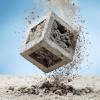
Breaking News
 Japan just injected artificial blood into a human. No blood type needed. No refrigeration.
Japan just injected artificial blood into a human. No blood type needed. No refrigeration.
 China Just Dropped a 6% TAX on Gold - The Market Wasn't Ready for This
China Just Dropped a 6% TAX on Gold - The Market Wasn't Ready for This
 Banks' Strategic Silver Market Manipulation During Off-Hours Trading
Banks' Strategic Silver Market Manipulation During Off-Hours Trading
 No new North Sea oil wells for first time since 1960
No new North Sea oil wells for first time since 1960
Top Tech News
 The 6 Best LLM Tools To Run Models Locally
The 6 Best LLM Tools To Run Models Locally
 Testing My First Sodium-Ion Solar Battery
Testing My First Sodium-Ion Solar Battery
 A man once paralyzed from the waist down now stands on his own, not with machines or wires,...
A man once paralyzed from the waist down now stands on his own, not with machines or wires,...
 Review: Thumb-sized thermal camera turns your phone into a smart tool
Review: Thumb-sized thermal camera turns your phone into a smart tool
 Army To Bring Nuclear Microreactors To Its Bases By 2028
Army To Bring Nuclear Microreactors To Its Bases By 2028
 Nissan Says It's On Track For Solid-State Batteries That Double EV Range By 2028
Nissan Says It's On Track For Solid-State Batteries That Double EV Range By 2028
 Carbon based computers that run on iron
Carbon based computers that run on iron
 Russia flies strategic cruise missile propelled by a nuclear engine
Russia flies strategic cruise missile propelled by a nuclear engine
 100% Free AC & Heat from SOLAR! Airspool Mini Split AC from Santan Solar | Unboxing & Install
100% Free AC & Heat from SOLAR! Airspool Mini Split AC from Santan Solar | Unboxing & Install
 Engineers Discovered the Spectacular Secret to Making 17x Stronger Cement
Engineers Discovered the Spectacular Secret to Making 17x Stronger Cement
Big oil invests in Eavor's "holy grail" pump-free geothermal loops

BP and Chevron have led a US$40 million investment round for a Canadian startup that claims to have developed a unique way to extract energy from geothermal heat on demand, using an unpowered looping fluid design that's already prototyped in Alberta.
Solar and wind are scalable renewable resources, but only produce energy when the sun and wind are up, not when the grid needs it. Hydro can respond well to demand, but it's not really scalable; the geometry of your dam dictates the size of your operation. Regular geothermal needs volcanic levels of heat, which restricts it to certain locations, the same way hydro needs mountain reservoirs.
There are lower-temperature, low-enthalpy geothermal projects out there that can generate energy from hot rock in a flexible, scalable, on-demand fashion, but according to Eavor CEO John Redfern, these haven't taken off because they lose between 50-80 percent of the power they generate in the task of pumping the water up and down.



